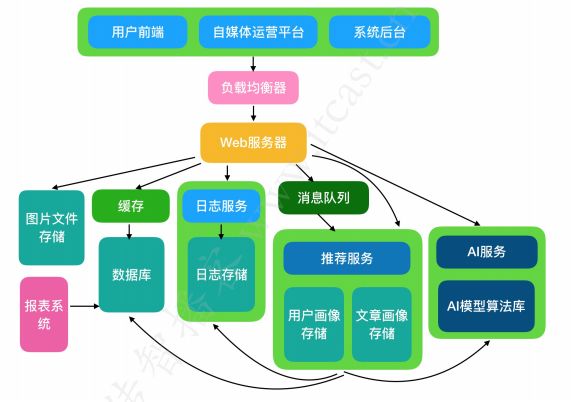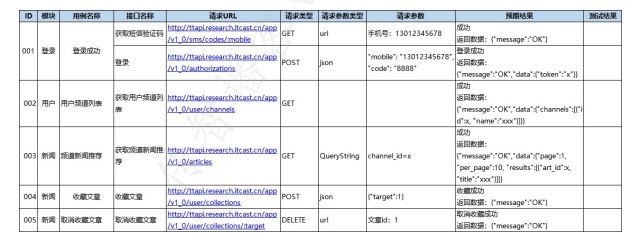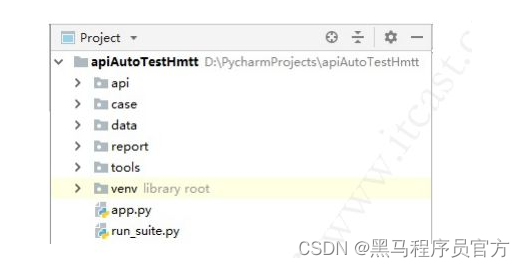目标
- 1. 熟悉接口自动化测试的流程
- 2. 能够对一个项目的接口实现自动化测试
接口自动化测试流程
- 1. 需求分析
- 2. 挑选需要做自动化测试的功能
- 3. 设计测试用例
- 4. 搭建自动化测试环境[可选]
- 5. 设计自动化测试项目的架构[可选]
- 6. 编写代码
- 7. 执行测试用例
- 8. 生成测试报告并分析结果
项目接口介绍
1. 项目介绍
项目名称:黑马头条
项目描述:黑马头条是一款基于数据挖掘的推荐引擎产品,它为用户推荐有价值的、个性化的科技资讯,提供连接人与信息的新型服务。
项目技术架构:

2. 项目接口分析
分析接口文档...
3. 挑选需要做接口测试的功能
用例设计
1. 单接口的用例设计

2. 业务功能的用例设计

项目搭建
1. 新建项目
项目名称:apiAutoTestHmtt
2. 创建目录结构

3. 安装依赖包
pip install requests
编写代码
1. 封装接口类
根据用例分析待测功能,按功能模块定义接口类
登录:login.py
频道:channel.py
文章:article.py
收藏:collections.py
2. 编写测试脚本
1. 定义测试脚本文件
登录模块:test_login.py
频道模块:test_channel.py
文章模块:test_article.py
收藏模块:test_collections.py
2. 使用unittest管理测试脚本
3. 执行测试脚本
1. 使用unittest执行测试脚本
2. 调试代码
4. 数据库数据校验
4.1 用例场景
调用收藏文章的接口后,校验数据库中是否插入了对应的收藏记录。
4.2 表结构
CREATE TABLE `news_collection` (
`collection_id` bigint(20) unsigned NOT NULL AUTO_INCREMENT COMMENT '主键id',
`user_id` bigint(20) unsigned NOT NULL COMMENT '用户ID',
`article_id` bigint(20) unsigned NOT NULL COMMENT '文章ID',
`create_time` datetime NOT NULL COMMENT '创建时间',
`is_deleted` tinyint(1) NOT NULL DEFAULT '0' COMMENT '是否取消收藏, 0-未取消, 1-已取消'
,
`update_time` datetime NOT NULL COMMENT '更新时间',
PRIMARY KEY (`collection_id`),
UNIQUE KEY `user_article` (`user_id`,`article_id`)
) ENGINE=InnoDB DEFAULT CHARSET=utf8 COMMENT='用户收藏表';
4.3 示例代码
# 收藏
def test_collections(self):
article_id = 1 # 文章id
user_id = 1 # 用户id
# 收藏
response = self.collections_api.collections(article_id)
# 断言响应数据
json_result = response.json()
self.assertEqual("OK", json_result.get("message"))
# 数据库数据校验
conn = pymysql.connect("localhost", "root", "root", "hmtt")
cursor = conn.cursor()
sql = "select collection_id,is_deleted from news_collection where user_id=%s and ar
ticle_id=%s"
cursor.execute(sql, (user_id, article_id))
data = cursor.fetchone()
cursor.close()
conn.close()
self.assertIsNotNone(data)
self.assertEqual(0, data[1]) # 未取消
4.4 封装数据库操作工具类
为了减少代码的冗余,提高测试效率,可以对数据库的相关操作封装成工具类。
示例代码
import pymysql
class DBUtil:
_conn = None # 数据库连接对象
@classmethod
def get_conn(cls):
"""获取数据库连接对象"""
if cls._conn is None:
cls._conn = pymysql.connect("localhost", "root", "root", "hmtt")
return cls._conn
@classmethod
def close_conn(cls):
"""关闭数据库连接"""
if cls._conn:
cls._conn.close()
cls._conn = None
@classmethod
def get_cursor(cls):
"""获取游标对象"""
return cls.get_conn().cursor()
@classmethod
def close_cursor(cls, cursor):
"""关闭游标对象"""
if cursor:
cursor.close()
@classmethod
def get_one(cls, sql):
"""查询一条记录"""
data = None
cursor = None
try:
cursor = cls.get_cursor()
cursor.execute(sql)
data = cursor.fetchone()
except Exception as e:
print("get_one error: ", e)
finally:
cls.close_cursor(cursor)
cls.close_conn()
return data
数据驱动
1. 数据驱动
1.1 定义数据文件
1. 定义存放测试数据的目录,目录名称:data
2. 分模块定义数据文件
登录模块:login.json
频道模块:channel.json
文章模块:article.json
收藏模块:collections.json
3. 根据业务编写用例数据
1.2 测试数据参数化
修改测试脚本,使用parameterized实现参数化
生成测试报告
使用HTMLTestRunner生成测试报告
report_file = "./report/report{}.html".format(time.strftime("%Y%m%d-%H%M%S"))
with open(report_file, "wb") as f:
runner = HTMLTestRunner(f, title="黑马头条接口自动化测试报告", description="V1.0")
runner.run(suite)









